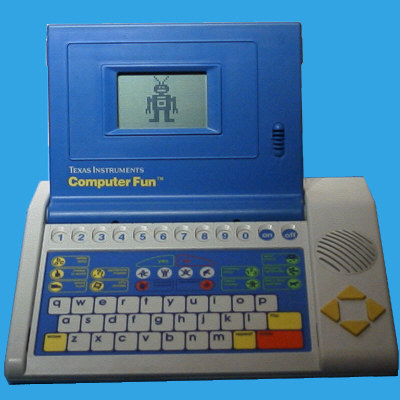
DATAMATH CALCULATOR MUSEUM
 |
DATAMATH CALCULATOR MUSEUM |
Texas Instruments Computer Fun
| Date of introduction: | 1988 | Display technology: | LCD |
| New price: | $63.75 (1992) | Display size: | Graphics |
| Size: | 9.5" x 12.5" x 2.5" | ||
| Weight: | 2 pounds 3 ounces | Serial No: | 5181571 |
| Batteries: | 4*AA cells | Date of manufacture: | wk 27 year 1990 |
| AC-Adapter: | Origin of manufacture: | USA | |
| Precision: | Integrated circuits: | TSP50C44 (CSM44012), TSP60C19 (CMM19006), HD44102, HD44105 |
|
| Memories: | |||
| Program steps: | Courtesy of: | Joerg Woerner |
 Texas
Instruments introduced with the Computer Fun a perfect combination of their
superb speech synthesizer technology known from products like the Super Speak
& Spell and the appearance of a small notebook.
Texas
Instruments introduced with the Computer Fun a perfect combination of their
superb speech synthesizer technology known from products like the Super Speak
& Spell and the appearance of a small notebook.
 The small graphics screen,
the arrow keys and the function keys let you play one of 12 different preprogrammed
games.
The small graphics screen,
the arrow keys and the function keys let you play one of 12 different preprogrammed
games.
READING READINESS• Letter Play: Letter recognition and keyboard layout
familiarity. |
EARLY MATH• Number Play: Number recognition and counting skills. |
CREATIVE PLAY• Creature Creation: Creativity and imagination. |
The toy is intended for players ages 4 to 8.
Dismantling this Computer Fun manufactured in July 1990 by Texas Instruments in the United
States reveals a rather complex printed circuit board
(PCB). The design of the Computer Fun is centered around four different Integrated
Circuits:
|
• TSP50C44/CSM44012: TSP50C50 VSP (Voice Synthesis Processor) with 8-bit microcontroller and 16k Bytes Mask ROM for both program and voice and
128 Bytes + 16 Nibbles RAM • TSP60C19/CMM19006: VSM (Voice Synthesis Memory) with 256k Bits • Hitachi HD44102: Column Driver for monochrome dot matrix liquid crystal display with 4-bit and 8-bit Interface for up to 50 columns • Hitachi HD44105: Common (Row) Driver for monochrome dot matrix liquid crystal display with 4-bit and 8-bit Interface for up to 32 rows |
The regional definition of the Computer Fun is accomplished with different Mask Versions for the ROMs of both the VSP and VSM:
|
• American Voice: TSP50C44/CSM44012 and TSP60C19/CMM19006 • British Voice: TSP50C44/CSM44017 and TSP60C19/CMM19040 • German Voice: TSP50C44/CSM44024 and TSP60C19/CMM19xxx |
In other countries like United Kingdom the Computer Fun got not only other voices, even the keyboard layout changed. Don't miss the German Computer Fun.
Later a similar product was sold with the Mouse Computer.
If you have additions to the above article please email: joerg@datamath.org.
© Joerg Woerner, December 5, 2001. No reprints without written permission.